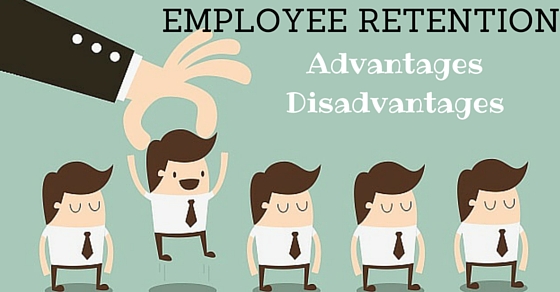Employees nowadays are seen leaving their organizations and moving on to other organization in no time.
The genuine reasons of place shift, family concerns have taken a back seat and there have been many new reasons that have come up for employees leaving the organizations.
The employees who leave the organizations are generally dissatisfied with current work or are looking for better opportunities outside, even within these two frames there are many small hidden reasons.
What is Employee Retention?
Employee Retention means strategizing to ensure that such employees do not leave the organization.
The question faced by many organizations is, whether it is beneficial or not? The answer to that can be found in the reason why employee is leaving the organization.

Why Employees Leave The Company?
When the organizations look deep into why employees leave the organization they can make a decision whether to retain them or not.
Some reasons for employees leaving are in the hands of the organization, other is more or less dependent on the employee and should be left on their discretion.
A few reasons which leads to the situation are-
1. Less Pay:
This has been the major reason why employees leave the organization. Organization has a budget with regard to employees’ salaries.
Employees think that the salary that they are offered are often too low compared to outside firms.
Employees’ even compare their own salaries with that of their co-workers. This creates a situation of disconcerting within the employee and they make a decision of moving out in search of better pay.
The problem here is that mostly the higher paid employees have more work experience with the company or is also amongst the one who has been a high performer.
Companies when they negotiate for packages have a limited scope of increasing them. Employees do not consider the perks that they enjoy here and only fight on the salaries.
Here a solution to retain them could be bonus, a pay hike or an additional perk that might be the concern of the employee. This however, in no way means that the company should stretch their budget and make the promises.
Doing that could lead to a negative impact on the organization and its finances.
2. Lucrative offers from Competitors:
There are times when employees within an organization are tempted by the competitors to leave their jobs and join them.
Mostly the targets here are high performing or experienced professionals who have been the reason for company’s growth and performance. These are the employees who are critical to the organization and should be retained.
Employee retention strategies should be designed to ensure that they stay back and remain loyal to the organization.
When they leave they take with them crucial information and expertise which is a loss to the organization.
Counseling, employee engagement and employee growth are a few strategies that can be few steps that the organization can take, to make sure that the employee is retained within the organization.
3. Recruitment Errors:
This could work both ways. Sometimes organizations are not clear about their expectations and work profile which makes employees feel that they are a mismatch and they tend to leave the organization realizing that their full potential is not utilized here.
The other error is from the employee side when they promote themselves on skills and attributes, that they are able to deliver later.
Most employees in order to impress the interviewer make promises that they are not able to deliver when they join the organization. This situation leads to a gap in expectations and delivery.
These employees eventually realize that they are not a fit and face daily stress in work and plan to leave the organization. They might be a misfit in the current profile but they definitely can be of use in some other function.
Organizations should realize that there has been a lot of cost that was incurred while hiring and training these employees’. They can also learn a few skills that are required for the new job thus, organizations should see if they can utilize them within the organization and retain them.
4. Private Issues or Personal issues:
Some individuals are always looking for a change; this is a part of their nature. They get bored or very soon start looking for a new job.
They always feel underutilized and are quick to make decisions.
These individual find the job quite interesting at the start but very soon look for a change as they feel they are now bored. They are likely to be making a mistake and will realize when they move out.
Organizations can make these employees realize their potential, their requirements and how the current organization should be the one they should remain with, to ensure they reach where they plan to. Changing jobs will not lead them to the desired results.
5. Too High Expectations:
Employees are also seen to be having high expectations from the organization, co-workers and themselves which on the real platform does not yield the expected results.
Employees then create issues for themselves and others and make decisions to leave.
Here if the expectations are unrealistic then employees should realize this and take decisions to stay and strike a balance in what is expected and should work towards creating a healthy atmosphere.
When employees clearly explain what they expect, then reasonable decisions can be made. There are times when certain expectations are not needed which can be curbed at the very beginning before they create issues.
Advantages and Disadvantages of Employee Retention:
| S.no | Advantages of Employee Retention | Disadvantages of Employee Retention |
| 1 | Costs and Benefits | Non performing employees are retained |
| 2 | Experienced employees | Groupism in Workplace |
| 3 | Culture of Organization | Bad Working Environment |
| 4 | Loyalty Benefits | Destructures the work culture |
| 5 | Quality at Work | Makes employee under performing |
| 6 | Workflow Issues and Problems | Effects the quality of work |
Benefits or Advantages of employee retention?
This is like stating the obvious that retaining your experienced employees is always beneficial.
However, sometimes organizations skip on these advantages and allow their employees to go, which creates a situation of loss for the organization.
Keeping in mind these reasons, organization should not make a wrong choice anytime.
1. Costs and Benefits:
There is a huge cost associated with every employee an organization has.
The hiring cost which was incurred during the initial phase, training cost that was a part of initial training, on job training and various mid-employment training, exit costs which would include payments, replacements and payouts.
All these costs add up to a lot of money for the organization.
It is always in the best financial interest to retain employees who are part of your success and failures.
The employees also do not get the full benefit of these costs unless they stay with the organization and utilize their potential.
2. Experienced employees:
When employees leave the organization they take away with them the expertise they have achieved over the years of the organization.
These employees know the process in and out and are most likely to achieve targets with best utilization of the resources when they feel that they are not compensated properly or they feel under resourced they take such decision.
It is always best for organizations to evaluate advantages and disadvantages of talent management for ensuring the reasons and retain such talent within the organization.
3. Culture of Organization:
It is never in the best interest that employees leave the organization frequently. Culture is built by the people in the system.
When there are employees who have been with the organization for long they bring with them a healthy working culture.
This is negatively reflected on the culture when employees leave the organization.
Building strong culture is one of the priorities of every organization and if retaining employees is beneficial for them then they should make efforts to ensure that a strong culture is built.
4. Loyalty Benefits:
Every organization needs loyal employees to ensure sustainability in long run. These loyal employees add to the company’s brand, satisfied customers and happy work place. There are many hidden benefits of loyal employees which can be seen on different platforms.
Strong Employee Retention policies in an organization will ensure that these loyalty benefits are enjoyed by the organization and the employees.
5. Quality at Work:
The work quality is adversely affected when employees who have been trained for a job leave the organization.
Employees leave creating a gap in the process, this creates troubles in managing daily tasks which affects the quality of work. Other employees are over burdened and feel exploited.
Immediate replacement of these employees becomes impossible and thus employee retention becomes advantageous to ensure quality of work.
6. Workflow Issues and Problems:
When the employees leave an organization, the work flow gets affected. Training would be required to ensure that a suitable employee takes over the task.
Till the time, a replacement is found, the work does not go as planned and this might affect the relationship with clients.
Employee Retention Disadvantages or Cons:
When employees who do not deserve the post are retained by an organization it creates a situation of loss. Here are a few situations when retaining an employee becomes disadvantageous.
1. Non performing employees are retained:
Who to retain is an important decision that every organization has to make. Retention works adversely when employees who are non-performing are retained.
There are times when employees are not ready to grow and they are a liability to the organization. These employees do not add value to the team and should not be retained.
This however calls for a good policy to ensure that these employees are identified.
2. Groupism in Workplace:
Retention many times makes the power to move in wrong hands. This happens when employees take it their head when they are retained over estimating their worth and create a negative group and influence others.
This groupism eventually starts affecting the quality and flow of work which might have been the major reason why they were retained at the first place.
This should be attended immediately to ensure that such groups do not grow strong.
3. Bad Working Environment:
Culture is an important reason why retention policies are needed, when retention starts destructing the culture then it is time to rethink.
Many times retention makes employees under performing and they demand more than they deserve. They even create a negative work environment.
The trick is to ensure that the one who is being retained has an intention to add to the positive environment and not create a negative environment at work.
Why Employee Retention is Important:
- The process of hiring is not so easy.
2. A firm invests money and time in training a person and prepare him/her to ready to work and view culture of corporate.
3. When an individual resigns from his present firm, it is more likely that he/she would join the rivalry.
4. Employees working for a longer period of time are more familiar with the firm’s policies, guidelines and thus they adjust better.
5. It has been observed that individuals sticking to an organization for a longer span are more loyal towards management and the organization.
It is essential for the organization to retain the valuable employees showing potential.
Great Strategies that Work for Employee Retention:
Retaining employees becomes easy when organizations use these simple strategies. Different strategies may work for different organizations and in different situations; every organization is the best judge as to which one will best work for them.
1. Focused recruitment:
This might seems vague and unrelated but when a company hire great employees and has clear demands and expectations it becomes unlikely for employees to leave the organizations later. The mismatch in the demands and expectation is what makes employee leave.
If focused recruitment is made then right candidate will be chosen for the job and when the employee demands are met in a fare manner, then there will be no reason for him or her to leave.
2. Creating Metrics to show:
There are times when employees feel that they are under or over utilized, they feel stagnant and they even feel they are not adding value.
In situations like these employees should have a researched metrics to show that they are growing. Their talent should be utilized and there should be a parameter where they could access this and feel good.
Employees generally are disheartened when they see that this is not happening. A show case is needed to ensure that ones who are desirable are appreciated.
3. Provide options:
Mostly employees feel trapped and this is when they feel like quitting. They might feel trapped in a job profile, it could be the client they are feeling stuck with, or it can even be their boss who is making their life miserable.
Such situations should be catered to, as this means that the employees who are leaving the organization are because of this feeling. Here flexibility in work and choosing out on few things can lead to a solution.
When employees have flexibility they can make way for themselves and be happy as they have nothing against the organization.
Employee Retention creates organization from falling in a pit hole of unfinished tasks and goals. It is a strategic decision that should be made after research and understanding the organizational needs.







































